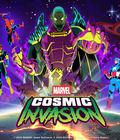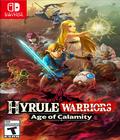Buy Hyrule Warriors: Age of Calamity
The Legend of Zelda: Breath of the Wild is up there with Majora's Mask for the darkest Zelda title. The game begins with Link awakening 100 years in the future to discover that most of his friends are dead, Zelda is missing, and Ganon has effectively won. The game spends a good amount of its time gradually dropping hints and clues about what happened. It isn't the long-awaited Breath of the Wild 2, but Hyrule Warriors: Age of Calamity finally gives us a look back at what the world was like before the Calamity Ganon.
Age of Calamity is set before Breath of the Wild — sort of. The game begins with a cute R2-D2-like guardian robot being sent back in time to the distant apocalyptic past that leads to Ganon winning and Link being put into stasis for a hundred years. From there, it gives a more in-depth view of the story and gradually leads up to an exclusive ending. The plot won't mean much if you aren't invested in Breath of the Wild, but it's a great way to see more of some characters.
The core gameplay of Age of Calamity is pretty much the same as in Hyrule Warriors. You control of one of the various Breath of the Wild characters and are thrown onto a huge battlefield where you need to slay enemies and capture bases to win. It retains a lot of the improvements made to later versions of Hyrule Warriors, such as the ability to deploy and swap between multiple characters. Age of Calamity makes much better use of that feature, since the game was designed around it instead of being stapled in after the fact. I'd argue it even makes better use of it than Fire Emblem Warriors, since it feels more naturally integrated.
One of the big things that sets apart Age of Calamity from the original is that it has a much better designed combat flow, especially when it comes to bosses. In the original game, you were stuck waiting for an enemy to show their weak point so you could damage it, but Age of Calamity makes that process feel more engaging. There are now a ton of different ways to reveal enemy weak points. If an enemy is defending, then bombs break their defense. If they are spinning or moving quickly, stasis breaks their defense. If they are charging, cryonis does the job. If they're throwing something metal at you, you can toss it back with magnesis. Doing so reveals their weak point for longer and allows you to inflict additional damage. You can also use magic rods, which are replenished by killing certain foes on the battlefield, to reveal a weak point, and when you hit the enemy with the correct elemental rod, they'll be stunned for longer and their weak points will be easier to break. There's also the ability to narrowly avoid an attack by using the Flurry Rush mechanic from Breath of the Wild, which automatically hits an enemy's weak spots.
This may sound like a small change, but it does wonders to make combat feel engaging instead of tedious. Rather than waiting for the RNG to give you what you need to do damage, you can proactively go after it. Any regular enemy attack is a chance to bait a Flurry Rush, and you do respectable damage even without an enemy being weakened; they just don't flinch, and you risk opening yourself up for counterattacks. If an enemy reveals their weak point, you can also use stasis on it to leave them vulnerable for a longer amount of time (assuming you didn't already use a slate ability to reveal it). I genuinely ended up looking forward to fights against named opponents in Age of Calamity, which wasn't a tedious grind-fest like some Warriors titles.
It also helps that Tecmo-Koei clearly learned a lot from the first Hyrule Warriors in designing how characters play. Pretty much every character is enjoyable and well designed, and you don't have super-awkward characters like Fi anymore. Instead, each character has a strong specific skill that plays into their basic abilities. Link's traditional sword-and-shield skill, for example, lets him pull out a bow at any time and is more effective in air, so you're rewarded for using combos that put you in the air. His two-handed sword skill allows you to substitute any strong attack for a much more powerful version that temporarily reduces your health. If you can back away before you're hit, you can regain the health by chowing down on meat, but one hit means you take damage and lose all of your temporary health.
Not every character feels equally powerful, but they all feel useful. For example, Mipha can perform lengthy combos, but her attacks can heal nearby allies, so she's extremely useful in a pinch. Revali the Rito can take off into the air, which increases his move set and damage but makes him harder to control; he'll be knocked out of flight if he takes damage, so players need to switch between the ground and air for maximum effectiveness. Urabosa stocks electricity with timed button presses, which she can then use to significantly amplify her combo fishers. The list goes on and on….
This uniqueness also applies to their Sheikah Slate skills. While every character has access to the same four skills, they use them in different ways. For example, Link throws multiple remote bombs quickly, while Zelda summons a tiny drone that spews bombs for a while. Zelda's stasis spell stops enemies, but can also be detonated early for bonus damage, while Impa freezes enemies in place so she can perform a special combo on them. Each tends to fulfill a similar function but in different ways, such as cryonis being a stepping stone that appears from the ground or a rotating shield of ice blocks. It's a nice way to add extra diversity to the characters while assuring they all have the same basic skill set.
I mentioned elemental damage earlier, but a nice feature of Age of Calamity is that it adapts Breath of the Wild's context-sensitive element bonuses to allow you to damage enemies in distinct ways. It's not quite as absurdly engaging as the freedom of Breath of the Wild, but it is an actual reason to pay attention to the battlefield, which often isn't a necessity in Warriors titles. Water can be frozen by Cryonis, which can freeze enemies solid or freeze you, if you aren't careful. It also makes electricity attacks more damaging, which is great if you're using one but terrifying if you're fighting an electric enemy. Grass can catch on fire to damage enemies. It's nothing game-changing, but it feels good to see a boss in the middle of a pool of water and freeze it solid before an attack.
All in all, Age of Calamity is more enjoyable to play than Hyrule Warriors, and Hyrule Warriors was already one of my favorite Warriors titles. It still has problems with repetitiveness — as any Warriors title does — but the changes to the combat system helps even the repetitive gameplay feel more engaging by rewarding aggressive play and constant movement. There are so many tiny little tweaks in addition to the big ones that I found myself far more engaged with the game, regardless of which character the title asked me to use. Rather than a separate adventure mode, the game has a unified world map where you collect materials to unlock new features and characters and complete increasingly difficult challenges for fun and profit. While I loved adventure mode and thought it was a decent replacement, it really makes the game feel more like Breath of the Wild's side-quest-hunting, world-exploring adventure.
The game's biggest problem is not unique to Warriors titles: It has some noticeable frame rate issues when playing while the Switch is undocked. It isn't as bad as the demo, but it does show up in busy battlefields where you're spewing lightning and beams. It bothered me significantly when I booted up the game, but I gradually got over it. The visuals are also very busy, which can make docked play frustrating, since you can't see anything between the special effects or the size of things.
Nowhere this is more apparent than the divine beast battles, which are skirmishes where control a giant robot animal and go to town on groups of enemies. It is similar to the Beast Ganon mode from Hyrule Warriors, but it's better implemented, with each of the beasts having its own play style. The downside is that because you're a giant robot fighting tiny things, it's often difficult — if not nearly impossible — to see what you're mowing through, leading to getting a thousand kills without much context. Beyond that, the beast modes are fun, but they're like a turret game mode in FPS: effectively trimming your move set to holding down the "fire" button and watching things die.
Age of Calamity adopts the Breath of the Wild art style perfectly, capturing the feel of that game enough that I recognized exact locations from the title, with lots of nice touches that make it feel like a Breath of the Wild spin-off as opposed to a reskinned Hyrule Warriors. The cut scenes have a lot of heart, and the voice acting is mostly on point. I was not fond of Zelda's voice actress in Breath of the Wild, but she does a lot better here, perhaps because the title gives her more to do. The music is also top-notch, with excellent remixes of many Breath of the Wild songs and some new originals.
Hyrule Warriors: Age of Calamity is an incredibly successfully follow-up to Hyrule Warriors, and in my opinion, it's the best Warriors title to date. It may lack the sheer unbelievable amount of content that Hyrule Warriors: Definitive Edition has, but what's available plays excellently enough that I didn't mind one bit. The only thing holding it back is the inconsistent frame rate and the innate repetitive nature of a Warriors game. If you liked Hyrule Warriors, Warriors games, or Breath of the Wild, then Age of Calamity is a must-have.
Score: 9.0/10
More articles about Hyrule Warriors: Age Of Calamity










 In Hyrule Warriors: Age of Calamity players will be transported to the time before the Great Calamity happened, participating in epic battles against a backdrop of familiar locations in Hyrule before they were destroyed.
In Hyrule Warriors: Age of Calamity players will be transported to the time before the Great Calamity happened, participating in epic battles against a backdrop of familiar locations in Hyrule before they were destroyed.























